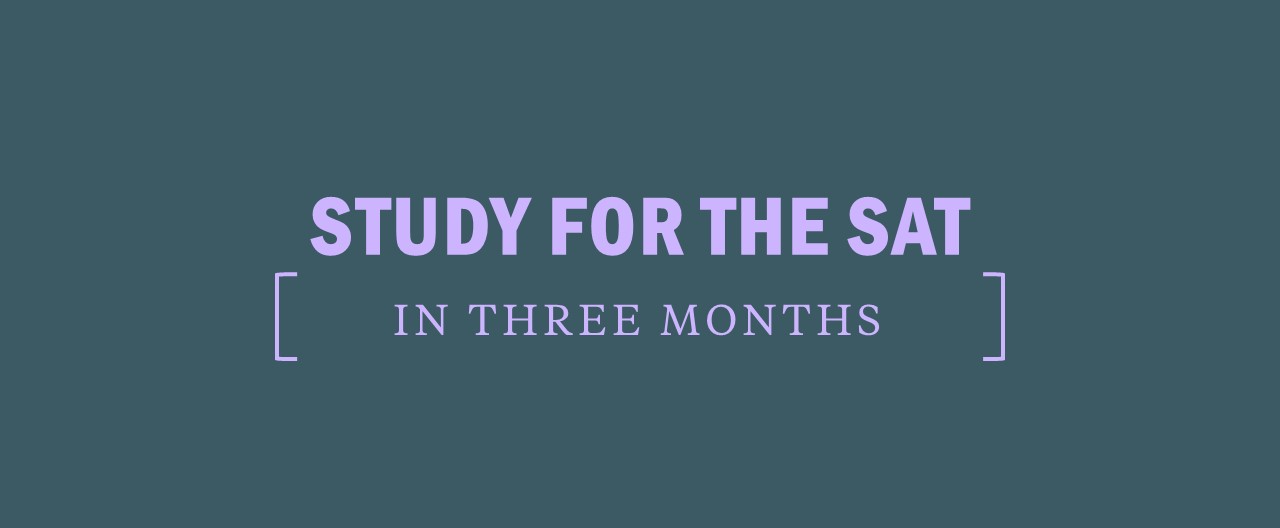How to Study for the SAT in 3 Months
Three months is a great amount of time to prep for the SAT. You can spread out your studying and you’ll have ample time to master the concepts tested on the SAT to get a good SAT score.
It can be difficult to know where to start your SAT prep. The key is finding the right resources, staying organized, and sticking to your plan.
[ RELATED: 1-Month SAT Study Plan ]
SAT PREP Resources
Before you get started with your SAT prep, you’ll want to equip yourself with the resources you need. As you consider the resources available, assess your learning style and ask yourself these questions.
- Do you study best on your own?
- Will working with an expert teacher or tutor help you stay motivated and on track?
TOP PICKS FOR SAT PREP
Get ahead of the most challenging parts of the new Digital SAT by taking this readiness quiz.
Before you start studying for the SAT, you’ll want to sit down and plan out a study calendar. By taking the time to do this at the beginning of your SAT prep, you’ll ensure that you have enough time to cover all of the material tested on the SAT, and that you incorporate enough practice with the test to become literate in its format.
The SAT is a standardized test, meaning it is always the same. The same types of questions are asked with new numbers or words. The more familiar you become with the structure of the SAT and its various question types, the more prepared you’ll be for Test Day.
At a minimum, you should plan to spend an hour a week on your SAT prep, though it’s recommended that you carve out 2-3 hours per week. The weeks in which you’ll be taking an SAT practice test (there are 4 in this 3 Month Study Plan) will require more time—plan to spend about 6 hours on SAT prep during these weeks. Err on the side of caution in the early stages—block out extra time for your prep. If you find that you are progressing towards your SAT score goal sooner than anticipated, you can decrease the amount of studying you have planned later on in your calendar.
As you make your study calendar, be sure to take into account all of your commitments and plan ahead. Keep your classes, homework, extracurricular activities, and work obligations in mind. Be sure, too, to make note of any family vacations or trips you may have planned during the three months. Plan to prep at least once a week for the entirety of the three months, or 2-3 times a week if you want to spread out the work.
SAT 3 Month Study Plan: Week One
Week 1 is about assessing your baseline score to get a sense of where you are starting from and how far you will need to go in your SAT prep.
Begin by taking a SAT full-length practice test in a single sitting. The SAT is 3 hours long, not including breaks. If you are completing the optional essay, add an additional 50 minutes. If you plan to complete the essay on Test Day, you should complete it on every practice test you take. You’ll want to build up your stamina, so resist the temptation to split up your practice tests over multiple sessions.
Once you’ve completed your practice test, score it. Use results from your first practice test to plan your studying in the following weeks. If the results from your first practice test indicate that you’re further from your score goal than you initially anticipated, you might consider carving out additional time on your study calendar each week, at least for the first few months.
On a separate day or two this week, set aside about 3 hours to review your practice test. This is the step that many students skip, but it is vital if you want to become as familiar with the SAT as possible.
How To Review SAT Practice Test Results
- Step 1: Start with the questions you got wrong, didn’t answer, or guessed on. One-by-one, review each question using the explanations provided. Take note of where you went wrong. Did you make a simple error in your calculations or do you need to flag a concept for deep review because you didn’t even know where to start?
- Step 2: Review the questions you got right. Read the explanations provided to see if there was a more efficient way to get to the right answer. Remember, since the SAT is standardized, reviewing all questions—even those you got correct—will help you master its structure and question types.
Stay organized in your practice test review, paying particular attention to patterns that you notice. Flag concepts that you got wrong at least 50% of the time for foundational review.
SAT 3 Month Study Plan: Weeks 2-4
Start your prep by studying any foundational concepts that you repeatedly missed on your practice test. For example, if you got most of the Systems of Equations questions wrong, it’s a sign that you need to delve deep into learning that content. Prioritize that work early on as it’ll take some time and practice to master.
Mix in a review of topics that you got right at least 50% of the time and be sure to spend some time these weeks learning test-taking strategies and methods for each of the sections.
What to Study During Weeks 2-4
- SAT Math: Linear Equations / Systems of Equations / Linear Inequalities and Systems of Inequalities
- SAT Evidence-Based Reading: Global and Command of Evidence Questions / Detail and Inference Questions
- SAT Writing: Organization / Development
SAT 3 Month Study Plan: Week 5
In Week 5, take another SAT practice test in a single sitting, and score your test.
What’s changed? Be sure to go beyond your score and review your practice test as you did in Week 1, taking note of which concepts you’d like to focus on in the following weeks.
Note: It’s not uncommon for students to see their scores dip in the middle of their studying. This is totally normal. As your brain takes on new information, it can sometimes feel overloaded and will slow down a bit to process what it’s learning.
Practice SAT Math Question
SAT 3 Month Study Plan: Weeks 6-8
Use the results from your second practice test to guide your studying these next three weeks. Be sure to cover all sections of the SAT, and to take some time in these three weeks to review the SAT Essay, if you are planning on taking it.
What to Study During Weeks 6-8
- SAT Math: Rates, Ratios, Proportions, and Percentages / Scatterplots / Two-way Tables, Statistics, and Probability / Exponents, Radicals, Polynomials, and Rational Expressions and Equations
- SAT Evidence-Based Reading: Connections and Vocab-in-Context Questions / Rhetoric
- SAT Writing: Organization / Development / Effective Language Use
- SAT Essay
SAT 3 Month Study Plan: Week 9
Time for another practice test! Take an SAT Practice test in a single setting, mimicking the experience of the actual SAT.
As you’ve done in past weeks, score the test, then fully review the practice test in separate sessions, taking note of concepts that you still need to study. Rework problems you got wrong until you really grasp the steps taken to get to the right answer. For questions you got right, make a note of any strategies you can employ for those question types to get to the right answer quicker.
SAT 3 Month Study Plan: Weeks 10-11
These two weeks are your last chance to study foundational concepts, so prioritize that work, especially with topics you are still getting wrong at least 50% of the time. Then, make sure to cover all remaining SAT topics, even those you get consistently correct.
What to Study During Weeks 10-11
- SAT Math: Functions / Quadratic Equations / Geometry / Imaginary Numbers and Trigonometry
- SAT Evidence-Based Reading: Synthesis Questions
- SAT Writing: Sentence Structure / Conventions of Usage / Conventions of Punctuation
It’s the week of the SAT! With at least one week to Test Day, take one last practice test. Then, spend a day or two reviewing the test. You should be a pro at doing this by now. Take notes of any missteps you may have taken and lightly brush up on foundational concepts as needed.
Then, take a few days off. Be sure to block off 1-3 days before Test Day. Do not cram. Instead, take some time to yourself to rest and recharge. In the days leading up to the test, do not change up your routine—go to bed when you usually do, eat the same breakfast, etc.
As your test date approaches, remember to refer to our 1-month SAT study plan for more targeted prep.
On the day of the SAT, wake up with confidence in your preparation. You’ve worked hard these past three months and you are ready. Walk into that room and crush it!


